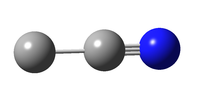|
The observed lines are from
(1) Y. Ohshima and Y. Endo,
1995, J. Mol. Spectrosc. 172, 225.
As in (1), effective A and γ values
were kept fixed to values in
(2) M. Kakimoto and T. Kasuya,
1982, J. Mol. Spectrosc. 94, 380.
In addition, a was kept fixed to the value
from
(3) M. D. Allen, K. M. Evenson, D. A. Gillett,
and J. M. Brown,
2000, J. Mol. Spectrosc. 201, 18.
With respect to the first entry from Aug. 2003,
additional millimeter wave data were taken
from
(4) J. K. Anderson, D. T. Halfen, and L. M. Ziurys,
2015, J. Mol. Spectrosc. 307, 1.
The data in (4) are much better than the residuals
suggest. There is likely a typographical error in one
transition frequency (59067.070 MHz was used
instead of 59067.007 MHz).
The fit has been carried out employing Hund's case (b),
as usual. Predictions for the lower spin-substate
2Π1/2 may be reliable up to
500 GHz, possibly higher.
Predictions for the upper spin-substate
2Π1/2 should be viewed with
great caution !
J + 1/2 = N
correlates with 2Π1/2
for J + 1/2 ≤ 7 and
with 2Π3/2 otherwise.
The dipole moment is from an ab initio calculation
by
(3) R. Pd. and P. Chandra,
2001, J. Chem. Phys. 114 1589.
Since the calculated dipole moment differs considerably
depending on the method and the basis set this value should
be viewed with some caution. Many calculation yield
values around 0.5 D.
|
